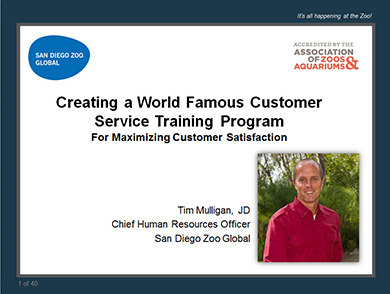 |
Customer Service Fundamentals |
1.00 |
In this course, you will learn about the importance of customer service and the pitfalls to avoid when providing customer service. This includes how to identify types of customers and their needs. Then, you’ll learn about building rapport with your customers through good customer service habits. Part of building rapport includes effective communication with customers, including how to correct a customer, the importance of body language and tone, and about telephone etiquette. You’ll learn how to respond to your customers and how to use questions. Then, you will be instructed about how to accentuate the positive and provide proactive service. Finally, you will learn how to surpass expectations by going the extra mile for the customer. |
 |
Volunteers and Change Management |
1.00 |
'Nothing is as permanent as change' - change is constant, change is life, but some changes are really difficult to navigate. This webinar will tackle how to build a strong and successful bridge to change using strategies for successful change management. Learn the best ways to use both your head and your heart to support others through change. |
 |
Implicit Bias |
1.00 |
In this course, you’ll learn about implicit biases that happen despite our best intentions. After completing this course, you will be able to:
Define implicit bias.
Describe how implicit bias can impact the workplace or an organization.
Identify the steps you can take to further educate yourself about this topic.
|
 |
Budgeting: Capital Budget Analysis |
0.75 |
A capital appropriation request form is a document that managers use to request capital funding for their departments. This is the first step in the documentation process for capital projects. |
 |
Employee Performance: Managing Difficult Employees |
1.00 |
A difficult employee is one whose attitude or behavior is detrimental to an organization. Typically, difficult people are aware of their behavior, but rarely care that their attitude hampers their productivity, or affects the success of their organization.
However, it’s important to remember that a difficult person is not necessarily an individual whom you dislike. Occasionally, the difficulty might not be the individual’s behavior but might instead be your perception of their behavior.
In this course you will learn to: recognize the impact that difficult people can have on an organization, manage a difficult person, and identify difficult personality types, address difficult employees, and mitigate their behavior, and monitor the behavior of a difficult employee, and document ongoing changes in behavior and performance. |
 |
Customer Service: Customer Service Skills |
1.00 |
A great customer service representative should have skills in three key areas: organization (time and stress management), motivation (letting customers know you care), and communication (vocal, verbal, and visual). The core strength of a good customer service rep is sound knowledge of the organization’s products and services. |
 |
Project Teams: Projects and Project Teams |
1.00 |
A project is a task or a group of tasks with a distinct beginning and end that is undertaken to create a unique product or service. A project must have defined objectives to clearly indicate when the project is complete. In addition, a project must have a clear end user who will use or benefit from the product or service produced by the project team.
When an organization develops temporary needs that are outside the scope of individual employees’ responsibilities, it often forms project teams to address these issues. As a manager, it is your responsibility to recognize the need for a project team, determine the type of team required for the project, and assign employees to the team.
In this course you will learn to: identify the phases and requirements of a successful project, and build and organize a project team and avoid pitfalls in project teams. |
 |
Budgeting: Budgeting Fundamentals |
1.33 |
A typical budget contains information for a single year and is updated and revised periodically. Each company creates a budget that fits its unique needs. A budget can be used for many purposes, but its primary functions should be to support strategic goals and to help identify when actual results deviate from what was predicted. |
 |
Budgeting: Reviewing Budgets |
1.00 |
A typical budget contains information for a single year and is updated and revised periodically. Each company creates a budget that fits its unique needs. A budget can be used for many purposes, but its primary functions should be to support strategic goals and to help identify when actual results deviate from what was predicted. |
 |
Managerial Leadership: Defining Employee Roles and Priorities |
1.50 |
A vision is created by an organization to inspire its members to work together to reach for an ideal of what the organization can become. The members of the organization should use the vision as the standard to determine the day-to-day functions of their individual roles. The vision is the guide to use every time an action is taken, a decision is made, or a plan is developed to improve the organization or the people in it. An organization’s vision should enable the members in every role to do what is in the best interest of the organization.
In this course you will learn to: determine leader roles and strengthen employee roles, and align employee priorities and evaluate employee performance. |
 |
Strategic Decision Making: Decision Results |
0.84 |
After implementing a decision, you should review the process you followed to reach it, regardless of the outcome. There are guidelines that you can use to review and learn from your decisions. You also need to be aware of the various pitfalls to avoid when learning from your decisions.
You can improve your decision making skills by examining a variety of other sources, such as the experience of people in your company and the decisions of other companies. You should not overlook these opportunities, because they will improve your decision-making skills, and help you to avoid similar mistakes in the future.
In this course you will learn to: identify the guidelines to follow and pitfalls to avoid when reviewing your decisions, and identify actions you can take to learn from the experience of others. |
 |
Customer Service: Responding |
1.00 |
After the greeting, listening, and questioning phases, the next phase is responding to a customer. Once you clearly understand a situation, your response will set the tone for the interaction. Without handling situations properly and without the right level of care, you can upset customers and ultimately drive them away. Responses must be timely and within expectations. If a customer is discussing a problem with you, then you know that at least one of that person’s expectations has not been met. |
 |
Advanced Interpersonal Communication: First Impressions and Building Rapport |
0.67 |
Although it only takes 30 to 45 seconds to formulate a first impression, it often requires four or five additional encounters to change someone's first impression. Many times, once you've made a first impression, you will not have a second opportunity to change that impression. Therefore, it's important to make your best impression on the first try.
In this course you will learn: to identify the elements that influence a first impression, to build rapport, and establish credibility with others, and to build positive relationships. |
 |
Project Teams: Communicating in a Project Team |
1.00 |
Although most people think of communication as the act of speaking, the act of receiving a message, or listening, is an extremely vital part of communication. Seventy to 90 percent of your time is spent listening, not speaking. Active listening includes not only hearing words that are spoken, but interpreting the verbal message and nonverbal communication as well.
During a project team meeting, you need to communicate with clarity to ensure that the entire team understands what is said.
In this course you will learn to: use good listening skills when communicating within a project team, understand and use good verbal communication skills and empowerment to communicate effectively within a project team, and receive and give feedback. |
 |
Correcting Performance Problems: Identifying Performance Problems |
1.50 |
An attendance problem occurs when an employee fails to report to work, doesn’t give proper notification of an absence, or exceeds the number of days allotted for absence.
You should address attendance problems carefully. Handling these problems poorly can lead to serious consequences, such as frequent employee turnover or workplace aggression. Before confronting an employee with an attendance problem, you need to identify the type of attendance problem and determine its severity.
In this course you will learn to: identify the types of attendance problems, assess their impacts, and determine a problem’s severity, identify the types of achievement problems, assess their impacts, and determine a problem’s severity, identify the types of conduct problems, assess their impacts, and determine a problem’s severity. |
 |
Interviewing Skills: Fundamentals Of Interviews |
1.00 |
An interview is a planned, focused conversation that provides an employer with information needed to evaluate a candidate’s ability and motivation to perform a job successfully. In addition, interviews enable you to analyze an individual’s potential fit with an organization. To select the right candidate, you need to have a range of interviewing skills.
In this course you will learn to: discuss the benefits of interviewing skills and identify the various types of interviews, and define the success factors for a position and identify the steps involved in writing and finalizing those success factors. |
 |
Budgeting: Operating Budgets |
1.00 |
An operating budget is a projection of the entire income statement of a company, or department. Operating budgets manage the operations of a company or department. They include the expenses associated with manufacturing, selling, and distributing products. Operating budgets also help to administer the daily functioning of the company. They project the expenses a company will incur in its manufacturing facilities, as well as the revenue that it will generate. |
 |
Managerial Leadership: Leading with a Vision |
1.50 |
An organization does not generate itself—it is founded by one or more people who take the initiative to put an idea into action. Leadership is the cement that unites members of an organization to achieve a common end.
Leadership helps members of an organization understand the organization’s purpose, and makes sure they do not lose sight of the organization’s vision. If an organization functions ineffectively, leadership helps members cope with the changes needed to improve the organization, enabling fulfillment of the vision or goals.
Leadership also helps members of an organization work to their full potential. If a team has the ability and resources to complete a task, leadership can provide the motivation and inspiration the team needs to complete the task.
In this course you will learn to: Identify a leader, define the vision of an organization and write a vision statement, and relate goals to the vision statement. |
 |
Advanced Interpersonal Communication: Organizational Culture |
1.34 |
An organizational culture is the personality of an organization. This personality is both determined and accepted by the organization’s members. For example, an organization might have a culture that is youthful, energetic, and fast-paced. In this type of culture, decisions are made quickly, and employees are empowered to take action in a wide variety of situations. Another organization might be more straight-laced and policy-oriented. This organization would be much more formal and serious in the way it does business. It is important to recognize and understand the culture of an organization, so that you can determine your fit with the organization.
In this course you will learn: to determine the nature of an organization’s culture, to use the cultural network to your advantage, and identify the characteristics of the roles exhibited in the network, to identify the elements of physical culture that affect interpersonal communication, and to identify the ways in which managers can build a positive culture. |
 |
Managerial Leadership: Making Vision a Reality |
1.00 |
An organization’s vision must be communicated in a manner that inspires people to participate in fulfilling it. Before members of an organization work to their full potential, they must first understand what it is they are working for—to make the organization’s vision a reality.
It is through communication that a leader gains support for the organization’s vision. People will not commit to something blindly, nor should they be expected to commit without information. Therefore, when, how, and to whom an organization’s vision is communicated is of great importance to the successful fulfillment of the vision.
Your organization’s vision must be communicated to the people who’ll have a hand in fulfilling it, as well as to the people who’ll be affected by it, such as clients or investors. Your organization’s vision should also be communicated to potential employees, or other people in the community who come into contact with your organization.
In this course you will learn to: communicate the vision, gain support for the vision, and empower employees, and implement the organization’s vision. |
 |
Customer Service: Greeting Customers |
1.00 |
Answering the phone when you know that you might be on the wrong end of a verbal confrontation is difficult, but it’s the first step in dealing with customer service issues. How you answer the phone will set a tone with the customer on the other end. Greeting a customer requires much more than a simple “Hello, how can I help you?” |
 |
Creating a World Famous Customer Service Training Program |
1.00 |
Are you interested in putting together a unique, world class, and cost effective Customer Service Training Program, rather than just purchasing one "off the shelf?" This webinar will walk you through the steps taken by San Diego Zoo Global to create its GRRREAT! Customer Service Training Program - all done in house! |
 |
Coaching: Interpersonal Meetings |
0.75 |
As a coach, your communication skills are critical to your success and the employees you are coaching. In many office environments, it can be tempting to get through the day without much personal contact by relying on technology. However, nothing can replace the benefits of personal interaction, or face-to-face communication. |
 |
Correcting Performance Problems: Investigating Performance Problems |
1.00 |
Before addressing a performance problem, you should confirm the existence of the problem itself. An interview is a useful method for doing this. During the interview, you might encounter facts that you were previously unaware of and excuses that you didn’t expect. It's important to follow a definite process, and expect the unexpected during the interview.
In this course you will learn to: identify the causes for an employee’s performance problem by interviewing, and question an employee regarding attendance issues, describe the factors affecting achievement, and apply conduct investigation techniques. |
 |
Quality Management: The Costs Of Quality |
0.50 |
Before the quality revolution that began in the United States in the 1980s, quality was frequently viewed as a goal that came at a higher price for production. However, the reality is that poor quality is a result of the ineffective use of resources, including wasted material and labor. Therefore, improved quality means better use of resources and lower costs.
In this course you will learn to: identify the relationship between quality and cost, the benefits of establishing quality requirements, management’s responsibilities for achieving conformance, and the costs of customer dissatisfaction. |


























